An Experimental Study on the Shear Hysteresis and Energy Dissipation of the Steel Frame with a Trapezoidal-Corrugated Steel Plate
Abstract
:1. Introduction
2. Cyclic Loading Test
2.1. Test Specimen Design
2.2. Cyclic Loading and Measurement
2.3. Strain Measurement
2.4. Theoretical Values of the Test Specimens
2.5. Elastic Shear Buckling of the Corrugated Plate
3. Analysis of the Test Results
3.1. Initial Stiffness and Collapse Load
3.2. Collapse Types of the Specimens
3.3. Load-Displacement Relationship
3.4. Strain Curves
3.5. Energy Dissipation Capability
4. Conclusions
Acknowledgments
Author Contributions
Conflicts of Interest
References
- Takahashi, Y.; Takamoto, Y.; Takeda, T. Experimental study on thin steel shear walls and particular bracing under alternative horizontal loading. In IABSE Symposium on Resistance and Ultimate Deformability of Structures Acted on by Well-Defined Repeated Loads; International Association for Bridges and Structural Engineering: Lisbon, Portugal, 1973; pp. 185–191. [Google Scholar]
- Thorburn, L.J.; Kulak, G.L.; Montgomery, C.J. Analysis of Steel Plate Shear Walls; Structural Engineering Report, 107; Department of Civil Engineering, University of Alberta: Edmonton, AB, Canada, 1983. [Google Scholar]
- Robert, T.M.; Sabouri-Ghomi, S. Hysteretic characteristics of unstiffened perforated steel plate shear panels. Thin-Walled Struct. 1992, 14, 139–151. [Google Scholar] [CrossRef]
- Wang, M.; Yang, W.; Shi, Y.; Xu, J. Seismic behaviors of steel plate shear wall structures with construction details and materials. J. Constr. Steel Res. 2015, 107, 194–210. [Google Scholar] [CrossRef]
- Jin, S.; Ou, J.; Liew, J. Stability of buckling-restrained steel plate shear walls with inclined-slots: Theoretical analysis and design recommendations. J. Constr. Steel Res. 2016, 117, 13–23. [Google Scholar] [CrossRef]
- Emami, F.; Mofid, M.; Vafai, A. Experimental study on cyclic behavior of trapezoidally corrugated steel shear walls. J. Eng. Struct. 2013, 48, 750–762. [Google Scholar] [CrossRef]
- Laszlo, G.V.; Abbie, B.L.; Gregory, G.D.; Eduardo, M.; Steven, T. Component model calibration for cyclic behavior of a corrugated shear wall. J. Thin-Wall Struct. 2014, 75, 53–62. [Google Scholar]
- Pasternak, H.; Hannebauer, D. Stahlbau Kalender 2004—4 Träger mit profilierten Stegen. Ernst Shon 2004, 449–492. [Google Scholar]
- Easley, J.; McFarland, D. Buckling of light-gauge corrugated metal shear diaphragms. J. Struct. Division (ASCE) 1969, 95, 1497–1516. [Google Scholar]
- Abbas, H. Analysis and Design of Corrugated Web I-Girders for Bridges Using High Performance Steel. Ph.D. Thesis, Lehigh University, Bethlehem, PA, USA, 2003. [Google Scholar]
- Abbas, H.; Sause, R.; Driver, R. Behavior of corrugated web I-girders under in-plane loads. J. Eng. Mech. 2006, 132, 806–814. [Google Scholar] [CrossRef]
- Driver, R.; Abbas, H.; Sause, R. Shear behavior of corrugated web bridge girder. J. Struct. Eng. 2006, 132, 195–203. [Google Scholar] [CrossRef]
- Arie, R.; Reza, S.; Huigert, H. Basic parametric study on corrugated web girders with cut outs. J. Constr. Steel Res. 2009, 65, 395–407. [Google Scholar]
- Eldib, M. Shear buckling strength and design of curved corrugated steel webs for bridges. J. Constr. Steel Res. 2009, 65, 2129–2139. [Google Scholar] [CrossRef]
- Sause, R.; Braxtan, T. Shear strength of trapezoidal corrugated steel webs. J. Constr. Steel Res. 2011, 67, 223–236. [Google Scholar] [CrossRef]
- Hassanein, M.; Kharoob, O. Behavior of bridge girders with corrugated webs: (II) Shear strength and design. J. Eng. Struct. 2013, 57, 544–553. [Google Scholar] [CrossRef]
- Nie, J.; Zhu, L.; Tao, M.; Tang, L. Shear strength of trapezoidal corrugated steel webs. J. Constr. Steel Res. 2013, 85, 105–115. [Google Scholar] [CrossRef]
- Shahmohammadi, A.; Mirghaderi, R.; Hajsadeghi, M.; Khanmohammadi, M. Application of corrugated plates as the web of steel coupling beams. J. Constr. Steel Res. 2013, 85, 178–190. [Google Scholar] [CrossRef]
- Ye, Z.; Berdichevsky, V.; Yu, W. An equivalent classical plate model of corrugated structures. Int. J. Solids Struct. 2014, 51, 2073–2083. [Google Scholar] [CrossRef]
- Gill, H.; Lee, S.; Lee, H.; Lee, P. A Study on the Geometric Parameters that Influence the Shear Buckling of Trapezoidally Corrugated Webs. J. Korean Soc. Steel Constr. 2003, 15, 591–602. [Google Scholar]
- Yi, J.; Youm, K.; Moon, J.; Lee, H. Shear Buckling Strength of Trapezoidally Corrugated Steel Webs. J. Korean Soc. Civil Eng. 2007, 27, 181–186. [Google Scholar]
- Moon, J.; Yi, J.; Choi, B.; Lee, H. Shear Design of Trapezoidally Corrugated Steel Webs. J. Korean Soc. Civil Eng. 2008, 28, 497–504. [Google Scholar] [CrossRef]
- Yi, J.; Gil, H.; Youm, K.; Lee, H. Interactive shear buckling behavior of trapezoidally corrugated steel webs. Eng. Struct. 2008, 30, 1659–1666. [Google Scholar] [CrossRef]
- Moon, J.; Yi, J.; Choi, B.; Lee, H. Lateral-torsional buckling of I-girder with corrugated webs under uniform bending. J. Thin-Walled Struct. 2009, 47, 21–30. [Google Scholar] [CrossRef]
- Yoo, M.; Shon, S.; Lee, S.; Kang, J. A Study on Shear Buckling Analysis and Boundary Condition of Sinusoidal Corrugated Plate by Using ABAQUS. J. Arch. Inst. Korea 2013, 29, 3–11. [Google Scholar]
- Shon, S.; Yoo, M.; Lee, S.; Kang, J. The Comparative Study on the Shear Buckling Stress of Trapezoidal and Sinusoidal Corrugated Steel Plate. J. Arch. Inst. Korea 2014, 30, 11–18. [Google Scholar] [CrossRef]
- Shon, S.; Yoo, M.; Lee, S.; Kang, J. A Comparative Study on Shear Buckling and Interactive Buckling Characteristics of Trapezoidal and Sinusoidal Corrugated Steel Plate. J. Arch. Inst. Korea 2015, 31, 39–46. [Google Scholar] [CrossRef]
- Shon, S.; Yoo, M.; Lee, S.; Kang, J. Minimum Weight Design of Sinusoidal Corrugated Web using Differential Evolution Algorithm. Int. J. Steel Struct. 2015, 15, 213–225. [Google Scholar] [CrossRef]
- Farzampour, A.; Laman, J.A.; Mofid, M. Behavior prediction of corrugated steel plate shear walls with openings. J. Constr. Steel Res. 2015, 114, 258–268. [Google Scholar] [CrossRef]
- Lee, S.; Yoo, M.; Shon, S. An experimental study on the shear hysteresis behavior of shallow corrugated steel plate. J. Archit. Inst. Korea 2015, 31, 11–19. [Google Scholar] [CrossRef]
- Hamilton, R. Behavoir of Welled Girder with Corrugated Webs. Ph.D. Thesis, University of Maine, Orono, ME, Canada, 1993. [Google Scholar]
- Mazza, F.; Vulcano, A. Control of the earthquake and wind dynamic response of steel-framed buildings by using additional brace and/or viscoelastic dampers. Earthq. Eng. Struct. Dyn. 2011, 40, 155–174. [Google Scholar] [CrossRef]
- Lindner, J.; Huang, B. Beulwerte für trapezförmig profilierte bleche unter schubbeanspruchung. Stahlbau 1995, 64, 370–374. [Google Scholar]
- KS D 3503. Rolled Steels for General Structure; Korean Standards Association: Seoul, Korea, 2014.
- KS D 3515. Rolled Steels for Welded Structures; Korean Standards Association: Seoul, Korea, 2014.

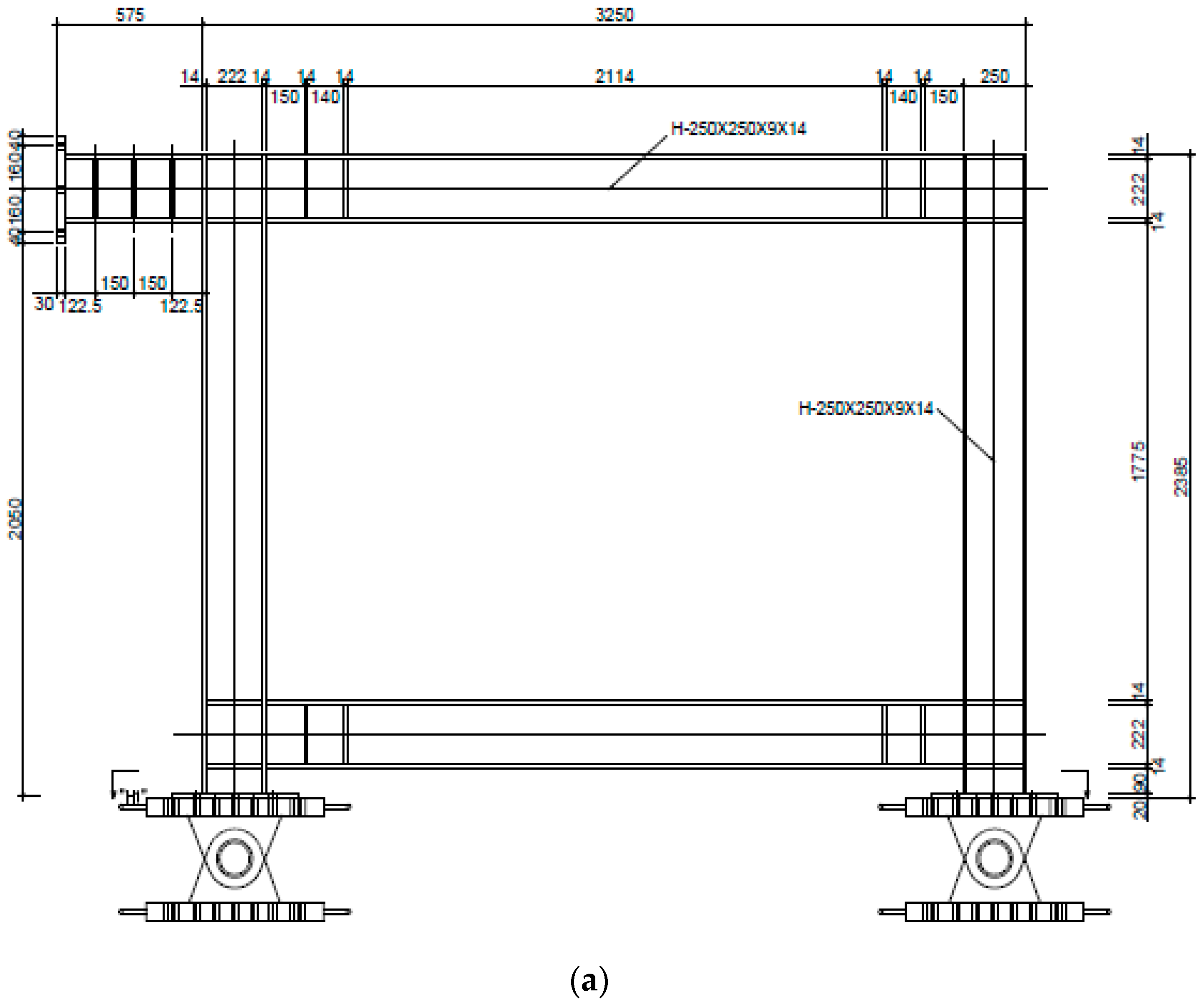
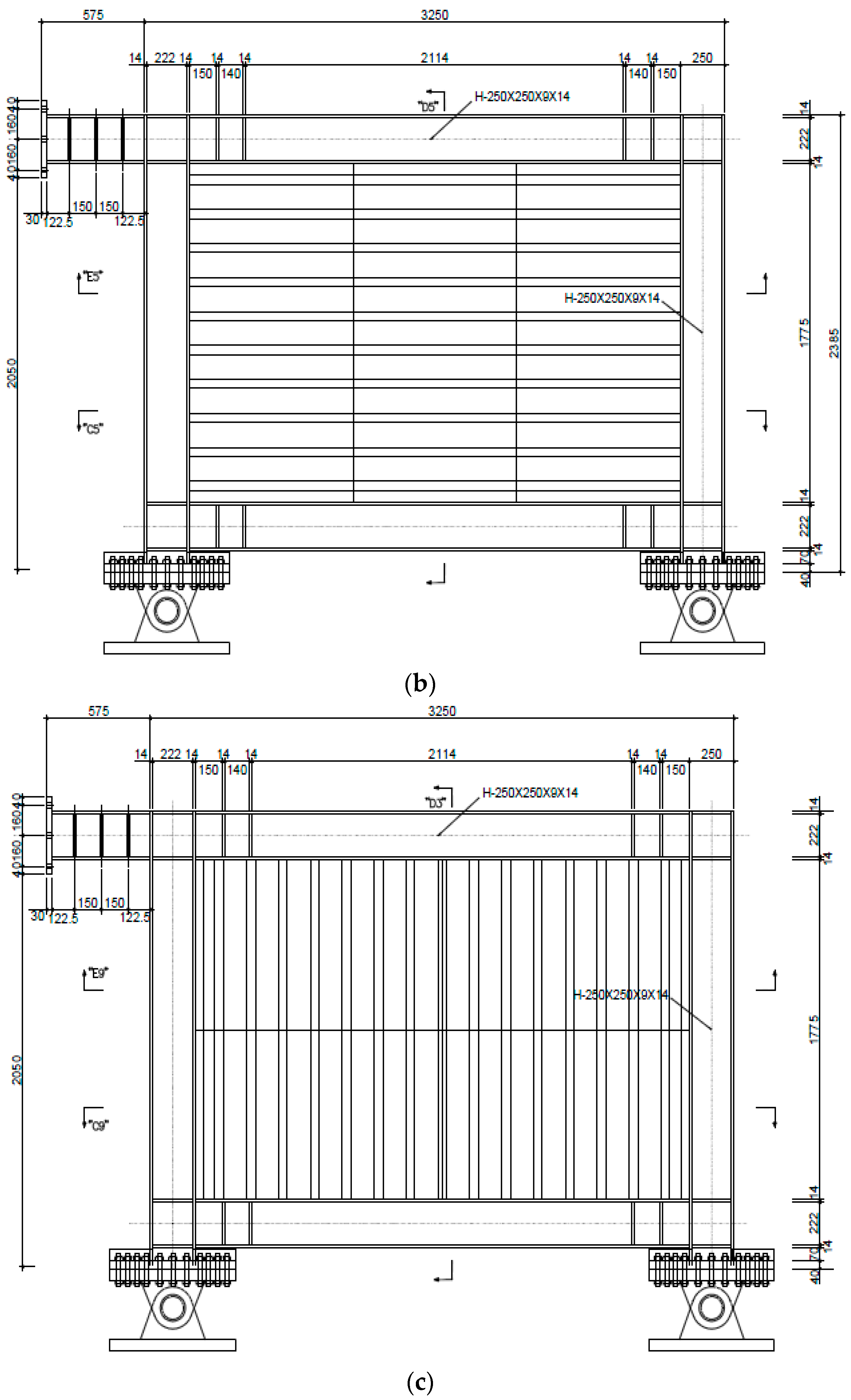

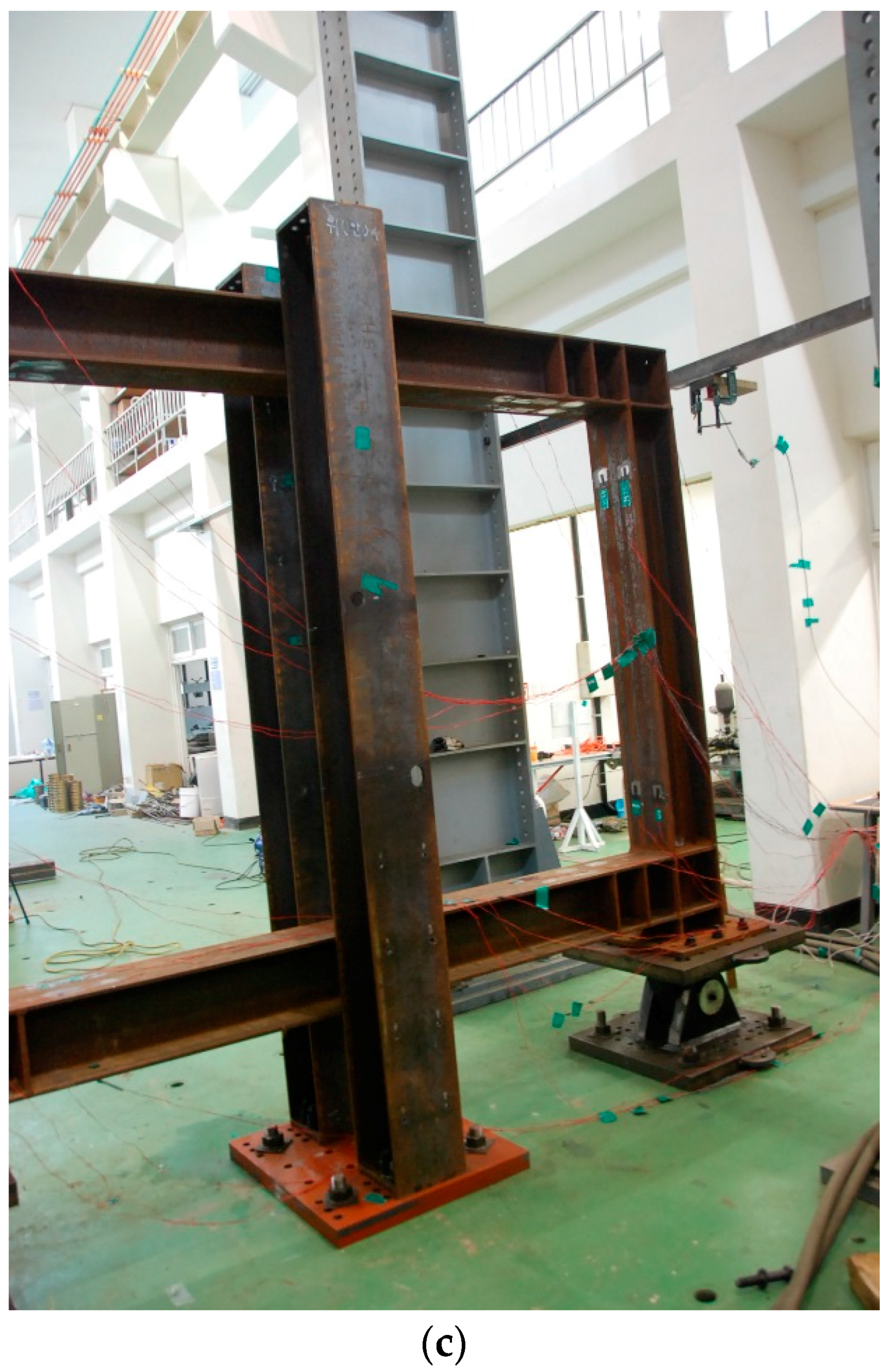
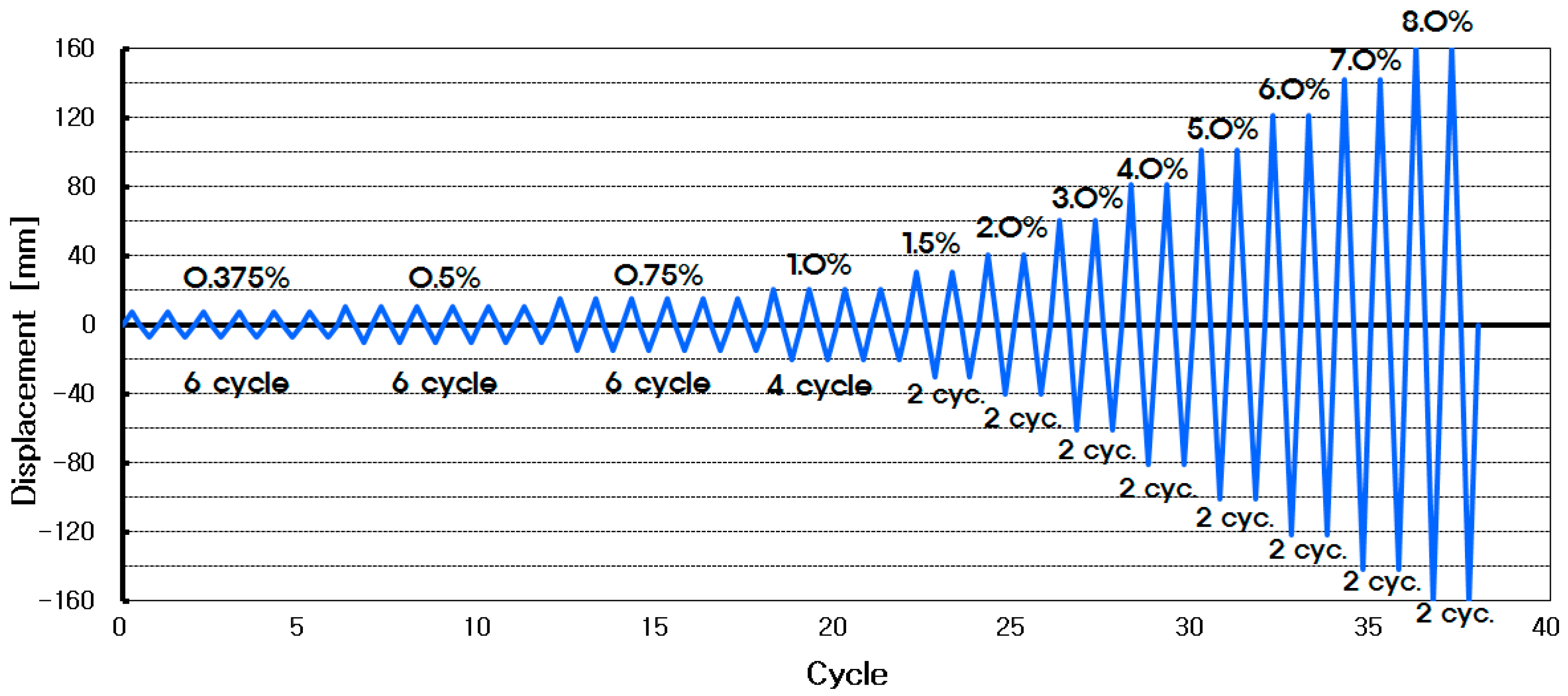

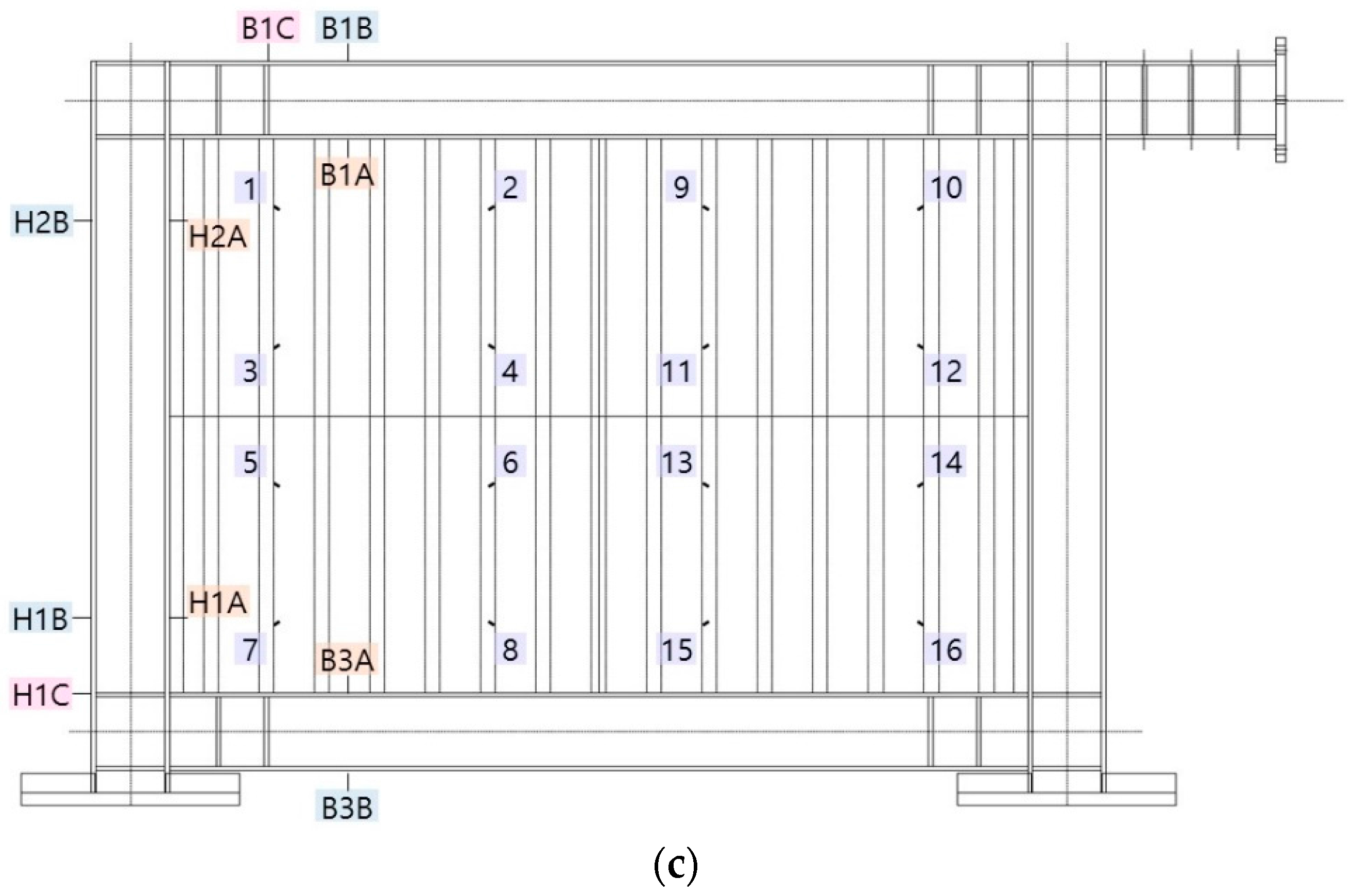

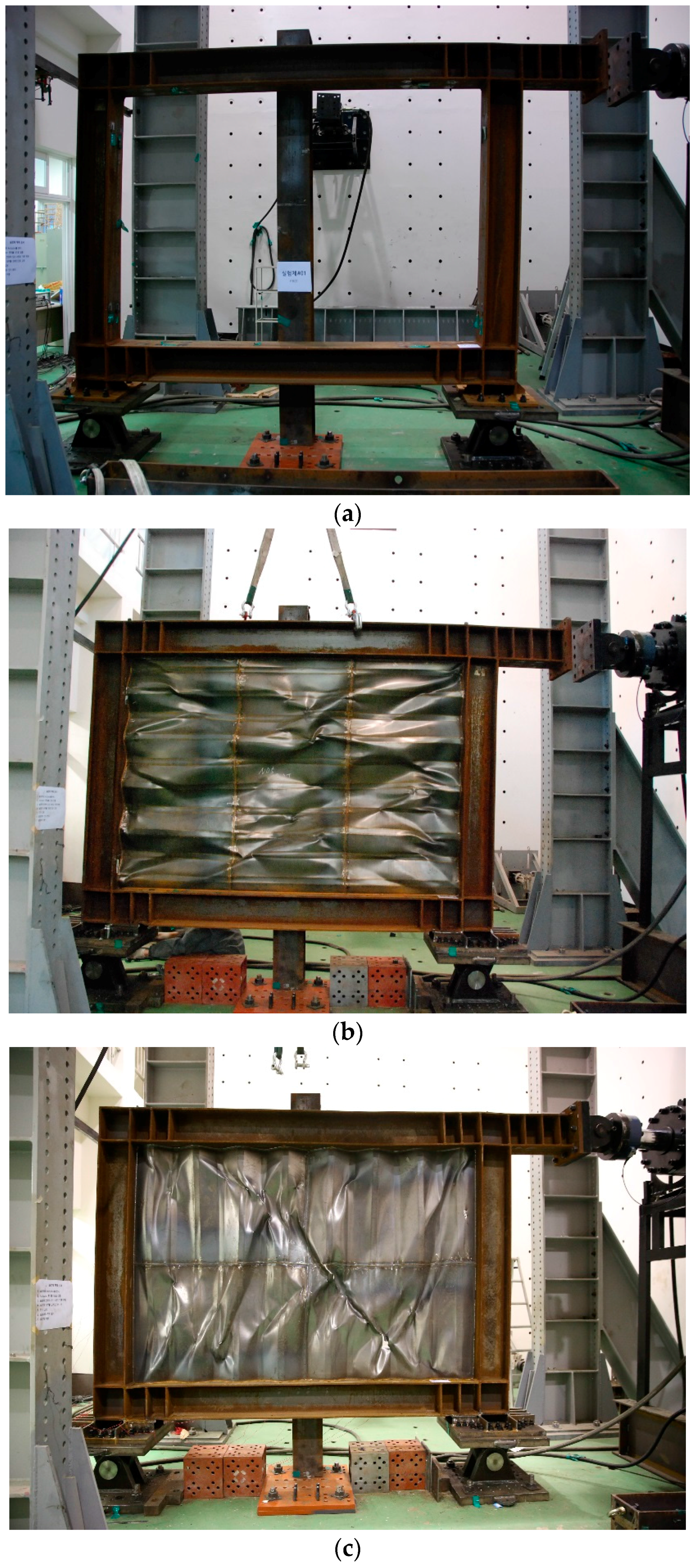
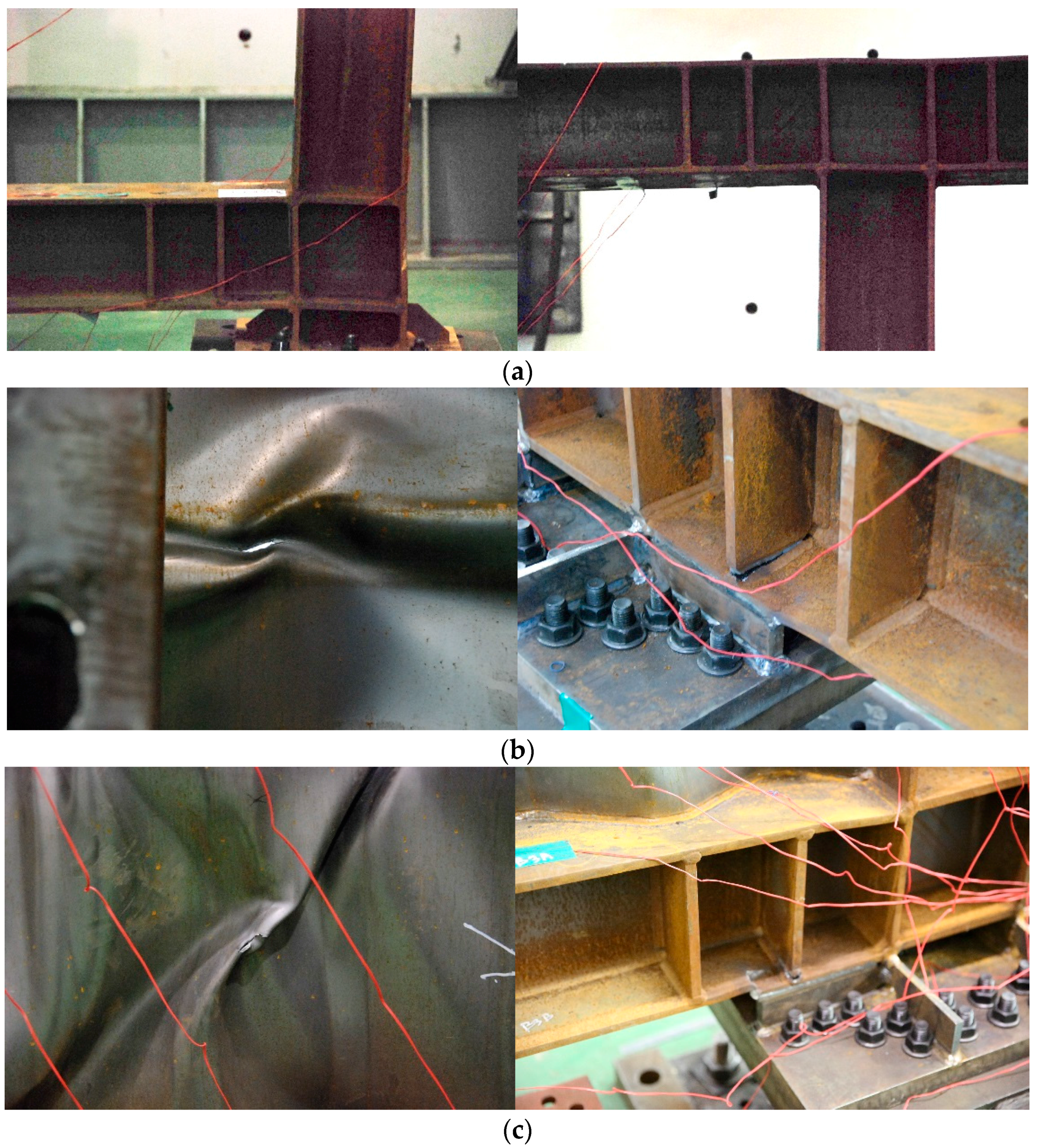
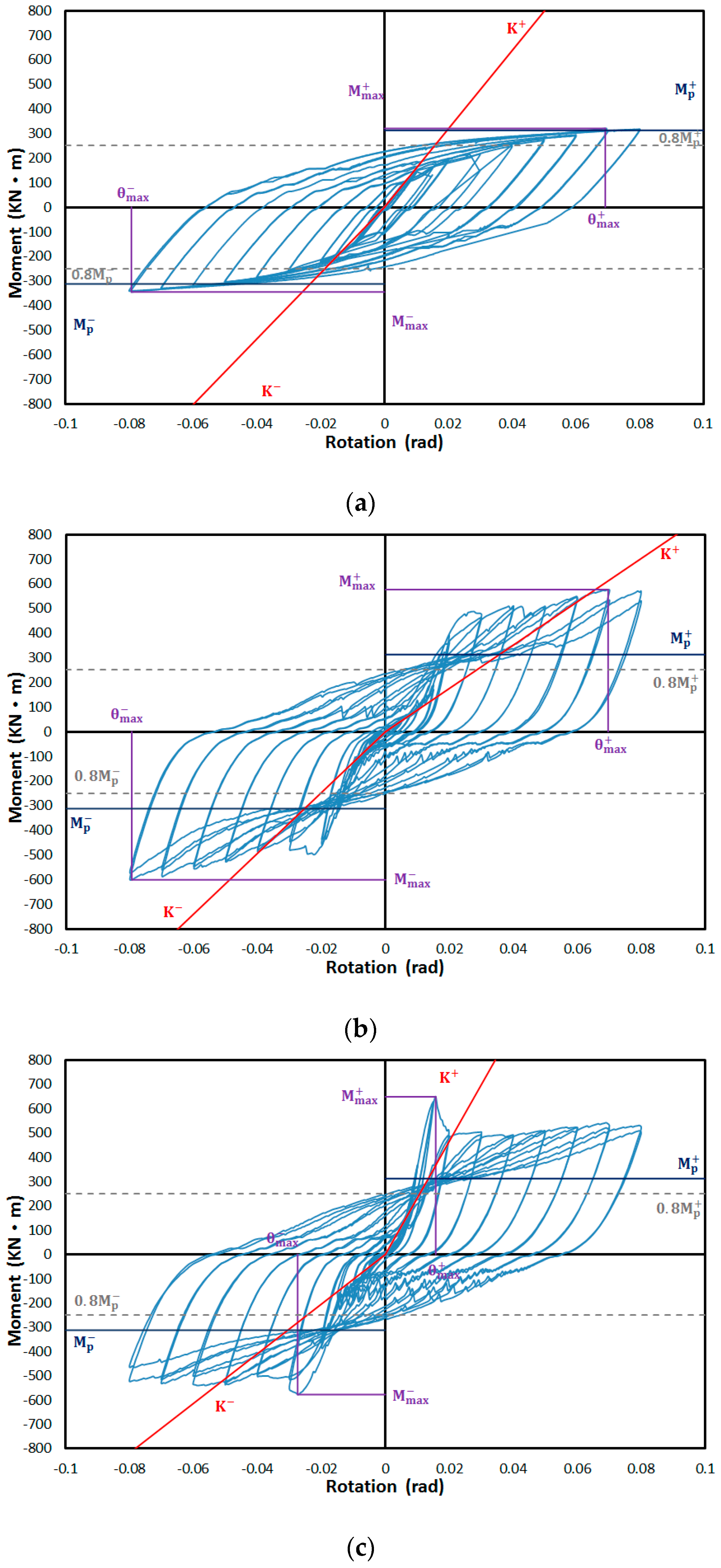
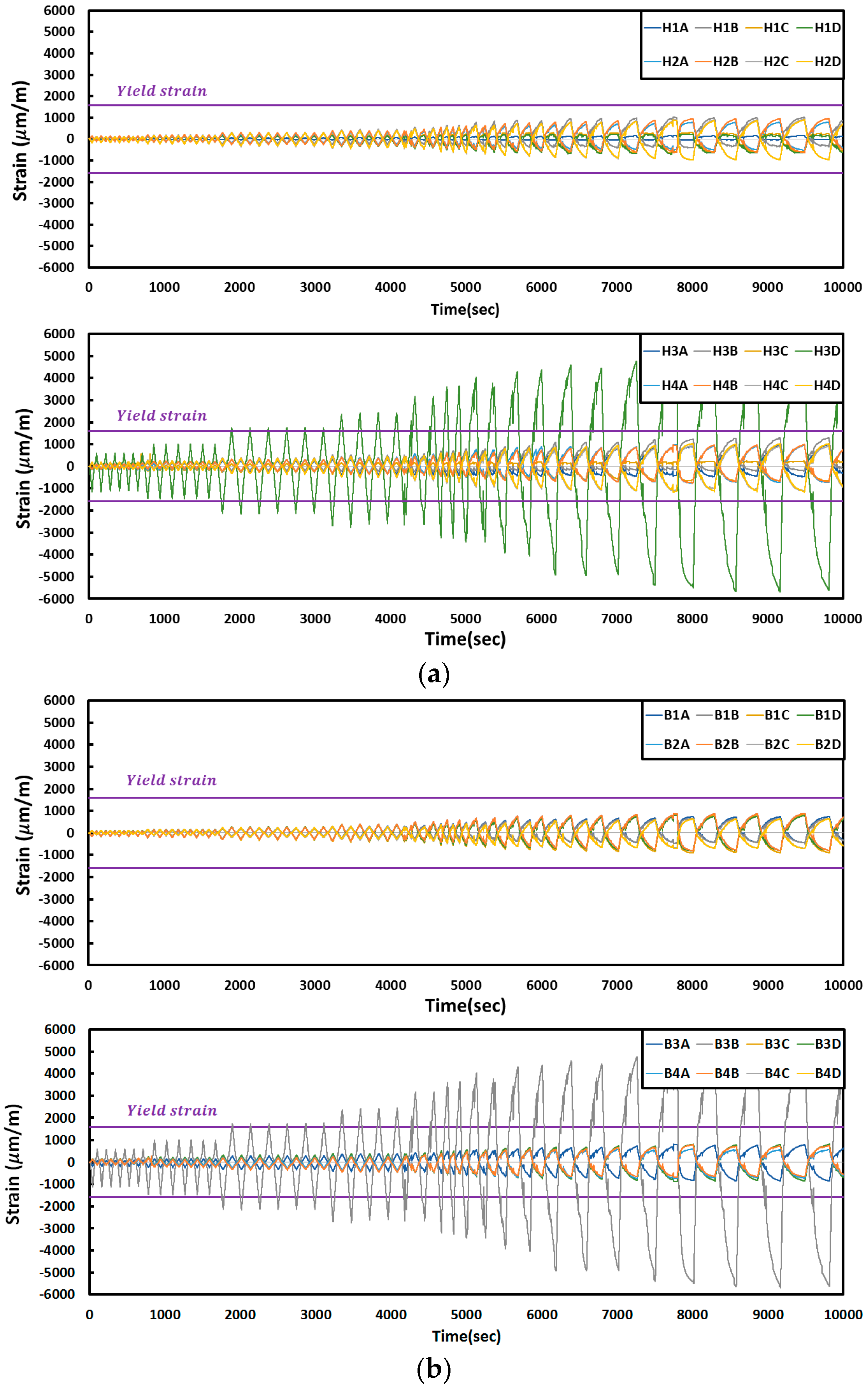
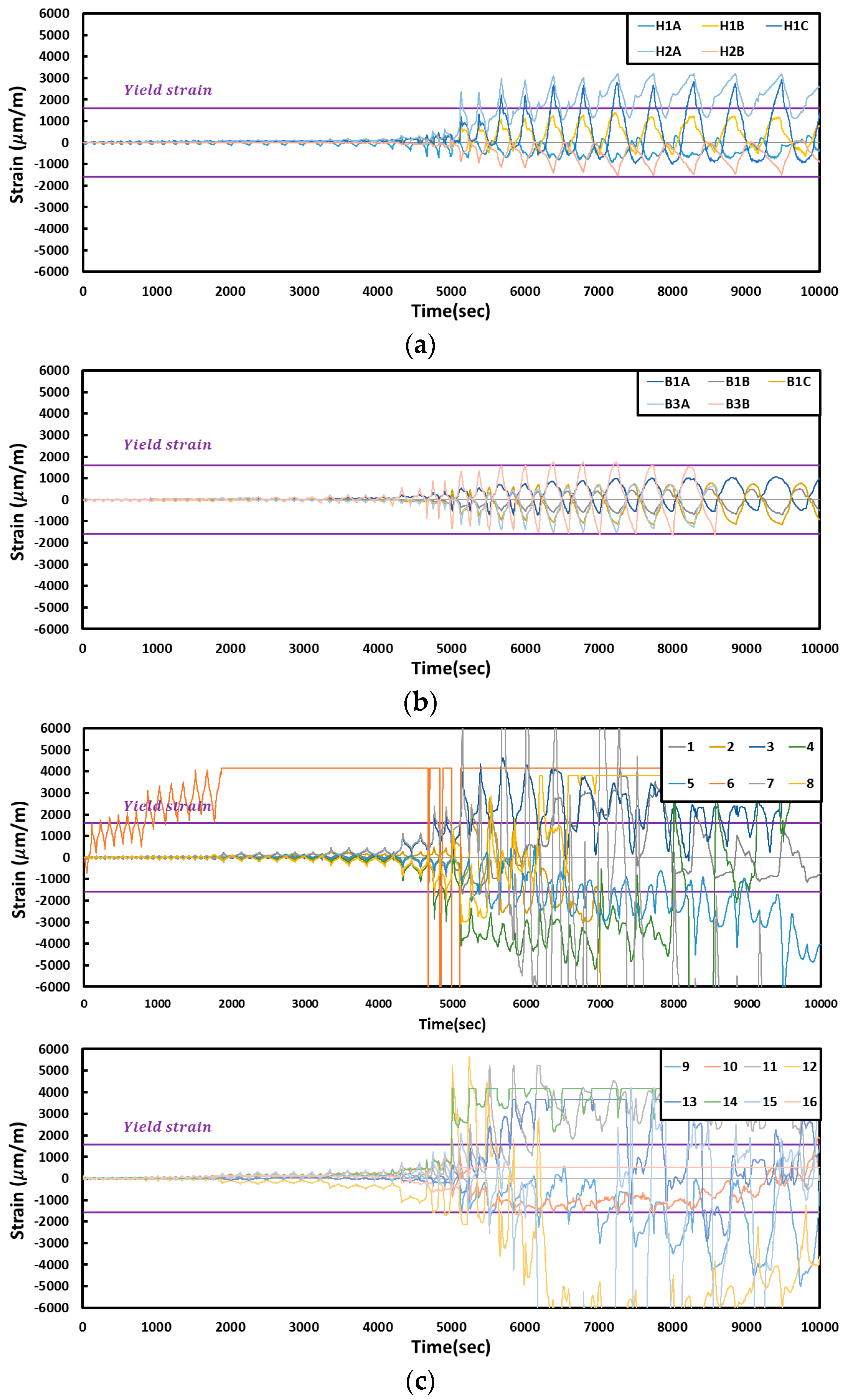

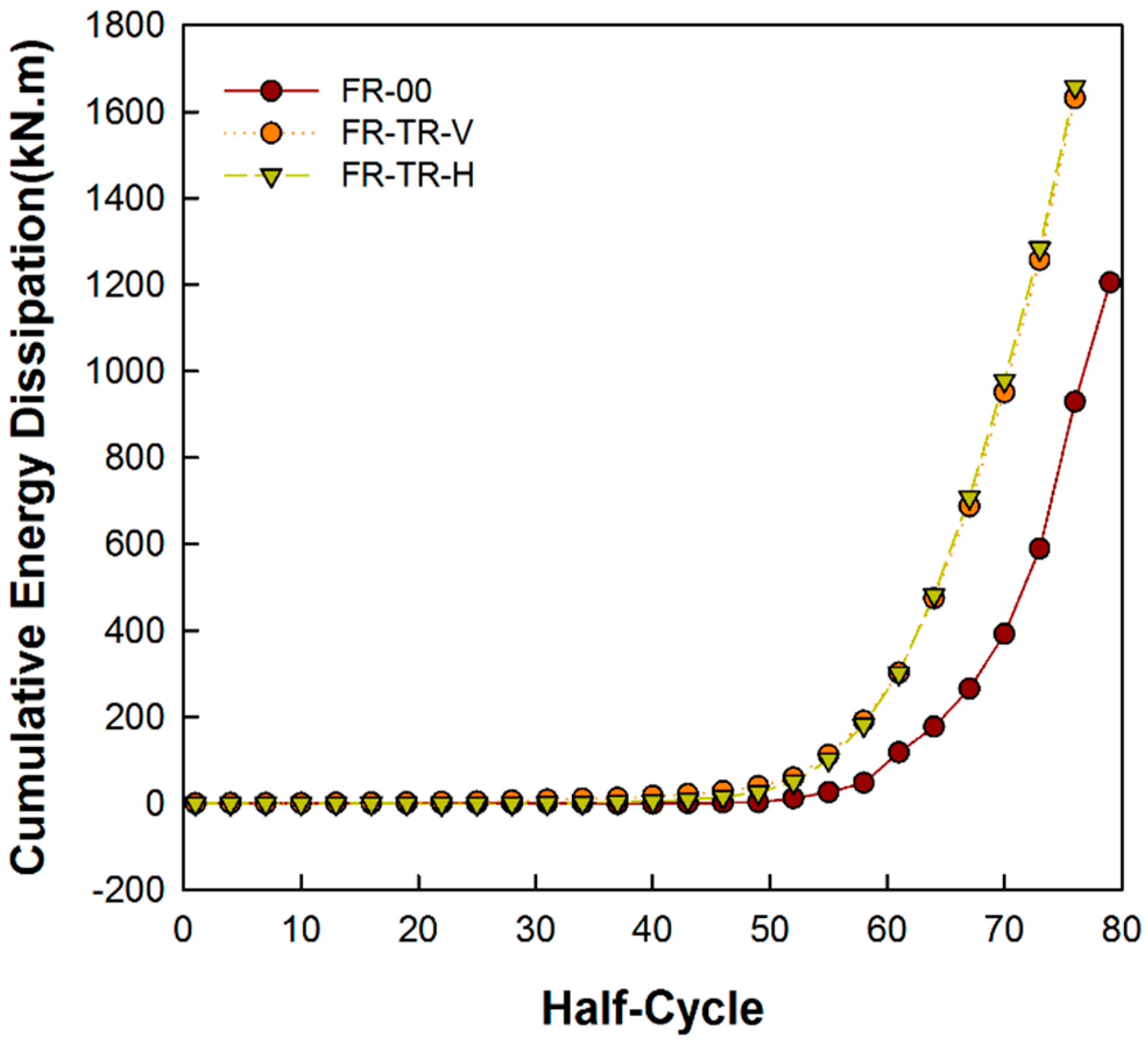
| Specimen | Column | Beam | H () | Parameters (See Figure 1) | ||
|---|---|---|---|---|---|---|
| FR-00 | H-250 × 250 × 9.0 × 14 | - | - | - | - | |
| FR-TR-V | H-250 × 250 × 9.0 × 14 | 917 (3.2) | 48 | 75 | 30 | |
| FR-TR-H | H-250 × 250 × 9.0 × 14 | 888 (3.2) | ||||
| Specimen | ||||||
|---|---|---|---|---|---|---|
| Corrugated plate of FR-TR-V | 4.527 | 2.897 | 2.440 | 0.640 | 0.802 | 2.324 |
| Corrugated plate of FR-TR-H | 4.513 | 1.207 | 1.166 | 0.267 | 1.607 | 1.940 |
| Specimen | ||||
|---|---|---|---|---|
| () | () | () | () | |
| FR-00 | 15,923 | 13,391 | 320.5 | 345.4 |
| FR-TR-V | 8781 | 12,319 | 575.9 | 601.2 |
| FR-TR-H | 23,282 | 10,236 | 648.5 | 577.3 |
| Specimens | FR-00 () () | FR-TR-V | FR-TR-H | ||
|---|---|---|---|---|---|
| () | () | ||||
| at 5% drift | 89.2 | 218.0 | 2.444 | 264.6 | 2.966 |
| at 8% drift | 599.5 | 1257.5 | 2.098 | 1283.8 | 2.141 |
© 2017 by the authors. Licensee MDPI, Basel, Switzerland. This article is an open access article distributed under the terms and conditions of the Creative Commons Attribution (CC BY) license ( http://creativecommons.org/licenses/by/4.0/).
Share and Cite
Shon, S.; Yoo, M.; Lee, S. An Experimental Study on the Shear Hysteresis and Energy Dissipation of the Steel Frame with a Trapezoidal-Corrugated Steel Plate. Materials 2017, 10, 261. https://doi.org/10.3390/ma10030261
Shon S, Yoo M, Lee S. An Experimental Study on the Shear Hysteresis and Energy Dissipation of the Steel Frame with a Trapezoidal-Corrugated Steel Plate. Materials. 2017; 10(3):261. https://doi.org/10.3390/ma10030261
Chicago/Turabian StyleShon, Sudeok, Mina Yoo, and Seungjae Lee. 2017. "An Experimental Study on the Shear Hysteresis and Energy Dissipation of the Steel Frame with a Trapezoidal-Corrugated Steel Plate" Materials 10, no. 3: 261. https://doi.org/10.3390/ma10030261






